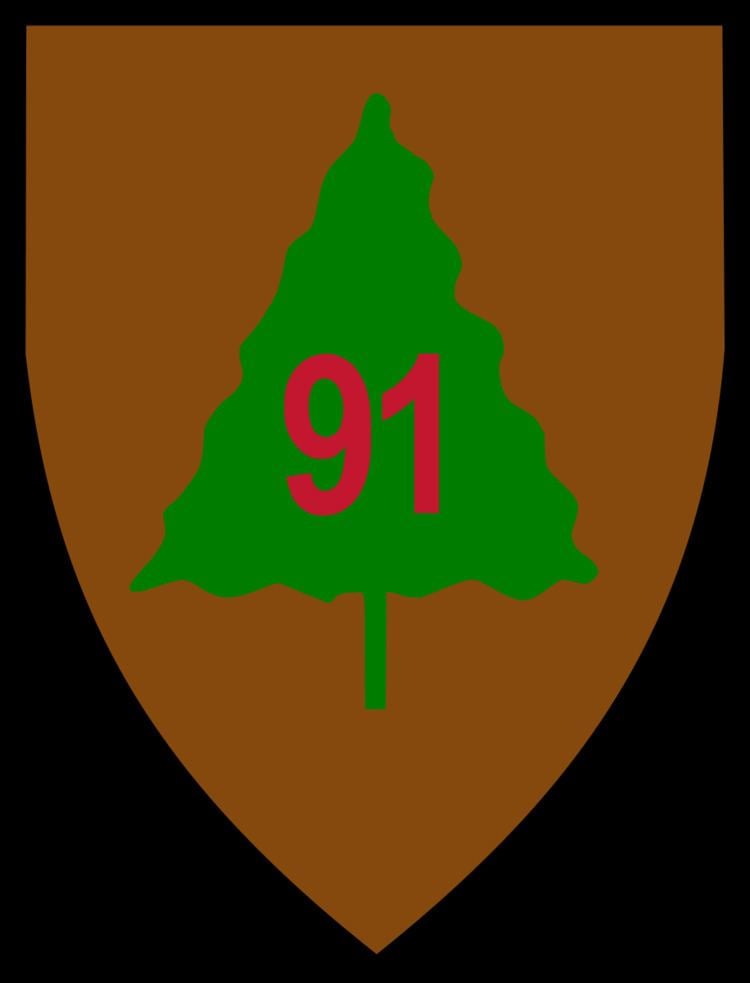Country United States Type InfantryTraining | ||
 | ||
Active 1917–19 91st Infantry Division1921–42 Inactive Reserve1942-1945 91st Infantry Division1946–2009 91st Training Division (USAR)2009-2010 91st Training Brigade (USAR)2010–present 91st Training Division (Operation) | ||
The 91st Infantry Division (famously nicknamed as the "Wild West Division" with a "Fir Tree" as its Division insignia to symbolize its traditional home of the Far West) was an infantry division of the United States Army that fought in World War I and World War II. From 1946 until 2008, it was part of the United States Army Reserve. It was briefly inactivated from 2008 until 2010 when it was elevated back to a division size element as the 91st Training Division (Operations).
Contents
World War I and after
Constituted on 5 August 1917 at Camp Lewis, Washington, near Tacoma, the division soon thereafter departed for England in the summer of 1918. In September 1918, the division's first operation was in the St. Mihiel Offensive in France. Serving under the U.S. Army's V Corps, the division fought in the Meuse-Argonne Offensive and successfully helped to destroy the German First Guard Division and continued to smash through three successive enemy lines.
Twelve days before the end of World War I, the division, as part of the VII Corps of the French Sixth Army, helped drive the Germans east across the Escaut River. The division was awarded separate campaign streamers for its active role in the Lorraine, Meuse-Argonne and Ypres-Lys campaigns.
In 1919, the 91st was inactivated at the Presidio of San Francisco. After being reconstituted in 1921 as part of the Organized Reserves, the division then served as an administrative control center for the next 21 years.
The Division was composed of the following units:
World War II
As the early battles of World War II involving the United States were being fought, the division was reactivated at Camp White, Oregon on August 15, 1942, under the command of Major General Charles H. Gerhardt. After initial training at Camp White, the division participation in the Oregon Maneuver combat exercise in the fall of 1943.
Then, the division, now under Major General William G. Livesay, departed for the European Continent on April 3, 1944. There, on the Italian Front, the 361st Regimental Combat Team was detached to participate in the battles for Rome and the Arno River. It became the first formation of the U.S. Fifth Army to reach the river. In September 1944, the division crossed the Sieve River, outflanked the famous Gothic Line, and captured the Futa Pass. For its part in combat, the division was awarded the North Apennines, Po Valley and Rome-Arno campaign streamers.
The division returned to the United States where it was inactivated at Camp Rucker, Alabama, in December 1945. Two members were awarded the Medal of Honor during the war, Roy W. Harmon and Oscar G. Johnson.
World War II statistics
Awards: MH-2 ; DSC-2 ; DSM-1 ; SS-528; LM-33; SM-43 ; BSM-4,152.
Theater: Mediterranean
Days of combat: 271
Campaigns:
Rome-Arno (22 Jan 44 - 9 Sep 44)
North Apennines (10 Sep 44 - 4 April 45)
Po Valley (5 Apr 45 - 8 May 45)
Casualties
Army Reserve
In December 1946, the 91st was reactivated at the Presidio of San Francisco as part of the U.S. Army Reserve. In 1959, the division was reorganized and redesignated as the 91st Division (Training). In 1993, the division was again reorganized and redesignated as the 91st Division (Exercise) and again in 1999 as the 91st Division (Training Support).
Its previous headquarters were at Parks Reserve Forces Training Area (PRFTA), Dublin, California.
In its 2005 Base Realignment and Closure Commission recommendations, the Department of Defense recommended relocating the 91st Division to Fort Hunter Liggett.
The four brigades of the 91st Division were redesignated as separate brigades:
The 91st Division moved its headquarters to Fort Hunter Liggett on 1 May 2009.
The 91st Division was reorganized and re-designated as the 91st Training Brigade (Operations) on 1 October 2009.
The 91st Training Brigade (Operations) was re-designated as the 91st Training Division (Operations) on 1 October 2010.
